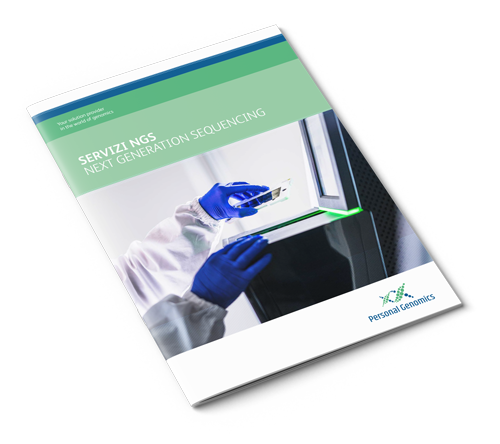DNA sequencing
We use Next-Generation-Sequencing technologies to analyze genomes, exomes and panels.
DNA sequencing includes the analysis of the genome, exome and gene panels customized to the customer’s needs. Our consolidated experience with a wide range of library preparation solutions allows us to provide consistent sequencing services. We are holders of a patent that allows you to select library preparation protocols, according to the best analytical coverage of the genes identified by customers.
SAMPLE PREPARATION
EXTRACTION
Nucleic acid extraction is one of the critical steps to obtain consistent and high quality NGS data. We are able to select the best kits for extraction from the different matrices (eg blood, plasma, paraffin, fresh tissue and saliva).
QUALITY CHECK
In the sequencing process we apply stringent quality control protocols that allow us to inform the customer in real time on the progress of the analysis. The main tools for checking the quality and quantity of the extracted DNA we use are: NanoDrop, LabChip and Qubit. For paraffinized samples, we are also able to evaluate the amplificability and the degree of fragmentation of the DNA.
SEQUENCING
The type of sequencing depends on the length of the library and the choice of capture kit. We mainly use Illumina sequencers, but we also have sequencing experience on other platforms, which can be used upon specific customer request.
EXOME (WES) AND PANELS
Selection of capture kits
We constantly evaluate the performance of new enrichment platforms. This allows us to have a proprietary database, which can be queried to evaluate which kit is most suitable for each region of the exome, from which we obtained the system for selecting the capture kit and fragment length present in the patent.
FULL GENOME (WGS)
We use PCR-free libraries to ensure the maximum possible coverage. Genomic libraries produced with protocols that involve the use of PCR, in fact, show a more irregular or absent coverage, which for us at Personal Genomics is not enough.
SEQUENCING
The type of sequencing depends on the length of the library and the choice of capture kit. We mainly use Illumina sequencers, but we also have sequencing experience on other platforms, which can be used upon specific customer request.
EXOME (WES) AND PANELS
Selection of capture kits
We constantly evaluate the performance of new enrichment platforms. This allows us to have a proprietary database, which can be queried to evaluate which kit is most suitable for each region of the exome, from which we obtained the system for selecting the capture kit and fragment length present in the patent.
FULL GENOME (WGS)
We use PCR-free libraries to ensure the maximum possible coverage. Genomic libraries produced with protocols that involve the use of PCR, in fact, show a more irregular or absent coverage, which for us at Personal Genomics is not enough.
IMPROVE GENOTYPIZZABILITY
To achieve maximum genotypability, we have developed capture library preparation protocols capable of modifying fragment length. By lengthening the fragment to an average length of about 300-350bp (against the 150-200bp foreseen by the standard protocols), it is possible to sequence with the 150PE protocol and, consequently, to improve the mappability of the sequences and the subsequent calling of the variants.
PANEL DESIGN
The coverage and genotyping information of the different capture kits as the average fragment length varies have allowed the development of an application, which allows you to choose the best possible configuration in the sequencing of a gene pool.
We at Personal Genomics have patented our method of producing libraries.
BIOINFORMATIC ANALYSIS
| I level bioinformatic analysis | II level bioinformatic analysis | III level bioinformatic analysis | |
| Demultiplexing | |||
| Production of FastQ files | |||
| Alignment | |||
| Call of variants | |||
| Annotation | |||
| Variant prioritization |
ALIGNMENT AND CALL OF VARIANTS
- Alignment on reference (hg19 or hg38) and production of BAM files;
- Call variants with BWA-mem / GATK4 pipeline and production of VCF files + genotyped regions.
The VCF reports information on the variants called in an individual and assumes that the lack of information is equivalent to the homozygous presence of the reference allele.
This assumption is false because a position may not be present in the VCF also due to lack of adequate coverage in the panel or due to low mappability. For this we provide a file that reports the genotyped regions.
As an alternative to the standard BWA-mem / GATK4 pipeline, a gVCF file can be produced using the iSAACalign / strelka pipeline.
COVERAGE AND GENOTYPIZABILITY ANALYSIS
We do NOT consider the theoretical coverages, but only the real ones, thus excluding:
- Off target
- Padded Region
- Duplicates
We at Personal Genomics have developed a pipeline to provide a detailed analysis of the coverage and genotyping for all coding regions in RefSeq in the case of a complete exome or the target region in the case of a panel.
